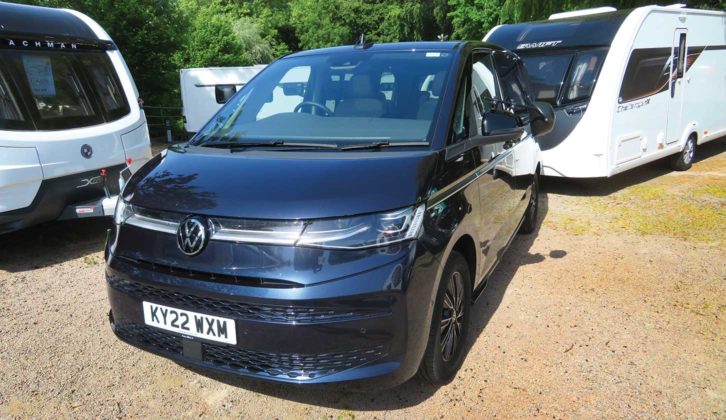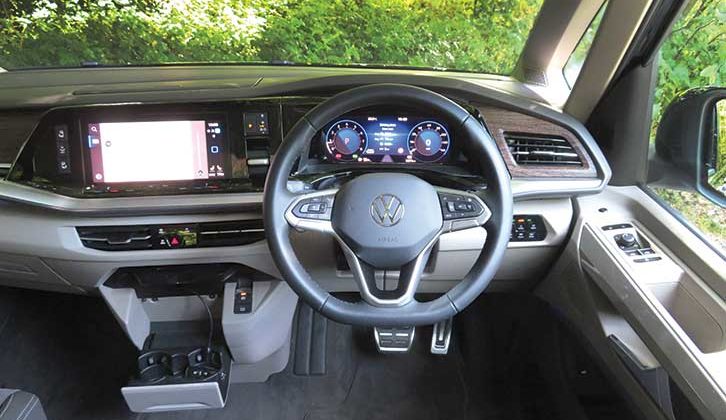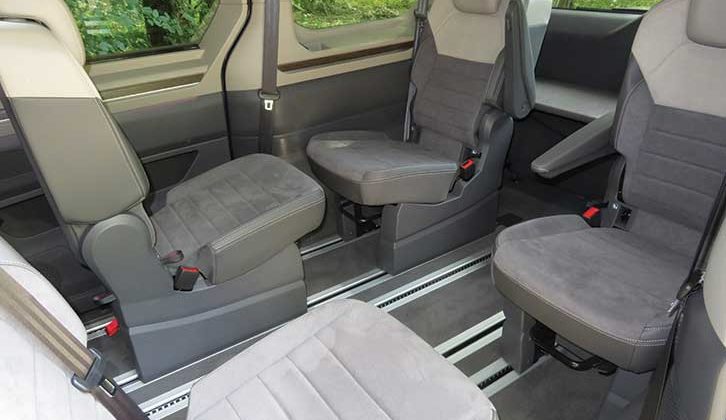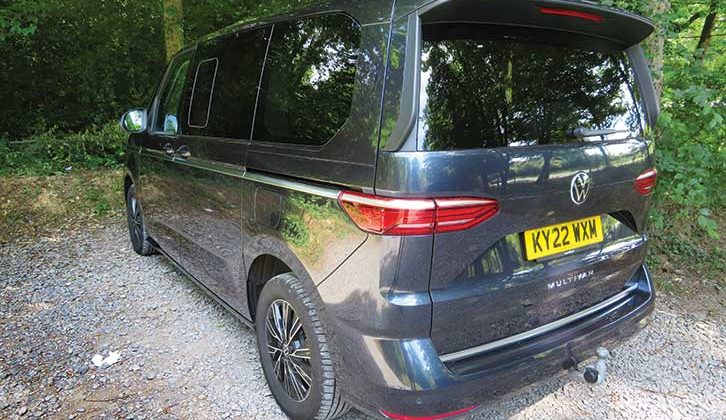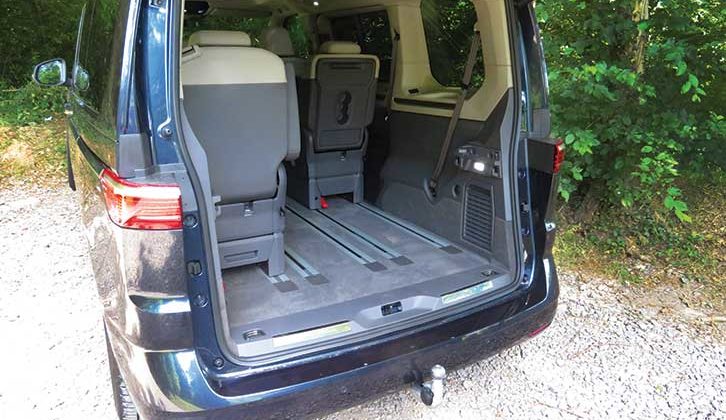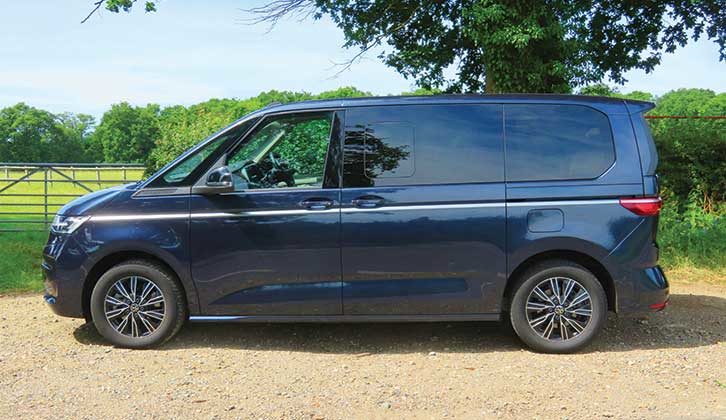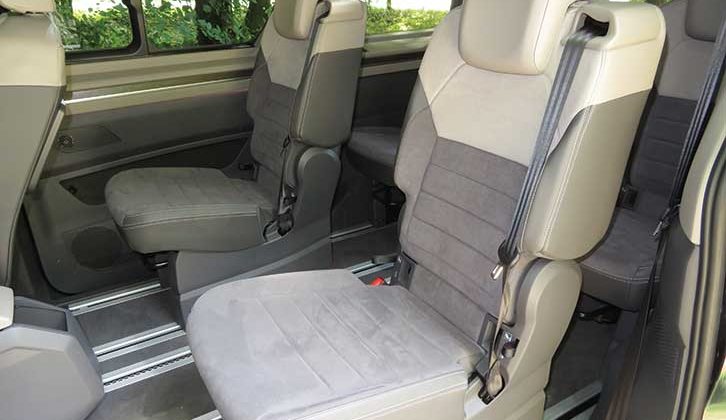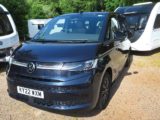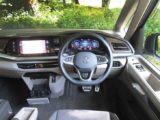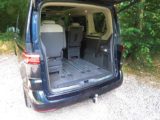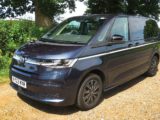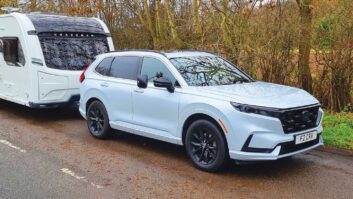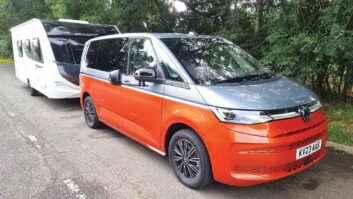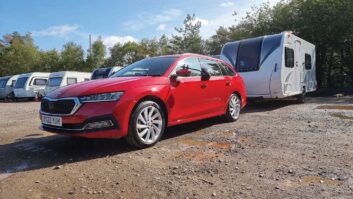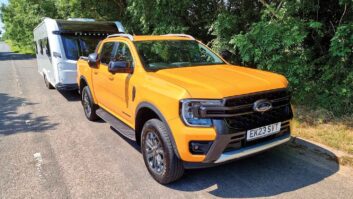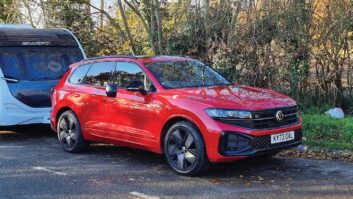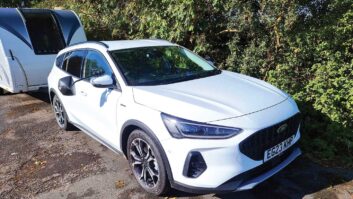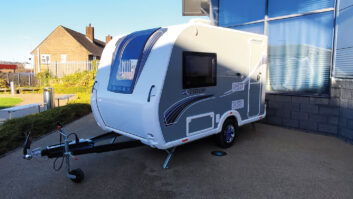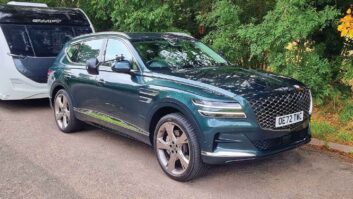The Multivan replaces the Caravelle, Volkswagen’s no-nonsense large MPV. Despite the name and the looks, it’s not based on one of VW’s vans – it actually uses the same underpinnings as most of their passenger car range.
It’s big on space, big on tech, but also big on price, starting from £48,883 and rising to £60,433 for the top-spec model.
That’s a lot of cash. Then again, the Multivan is a lot of car. Go for the standard wheelbase model we’ve been driving, and it’s just shy of 5m long, with an enormously roomy and practical interior.
What are we looking for?
We want to know if the Multivan is good enough to justify its premium pricing. What’s more, we’re keen to find out if the VW makes a viable alternative to a big 4×4, as well as other large MPVs.
You can also take a look at our best tow car guide for our pick of the standout towing vehicles on the market.
Towing ability
The Multivan is heavy. Even the lightest version has a kerbweight of 2036kg. That’s for the 136hp 1.5 TSI petrol, which sounds like it might be a bit underpowered, even before you add the weight of a caravan.
Other engine options look better bets for regular towing. There’s a 150hp diesel, with kerbweights from 2166kg and a 2000kg towing limit. The greenest option (so long as you recharge often) is the 1.4-litre petrol plug-in hybrid tow car, which has a kerbweight of at least 2217kg and a 1600kg towing limit.
We’ve been testing the 204hp petrol. The 2123kg kerbweight gives an 85% match figure of 1805kg, which is well within the 2000kg towing limit.
It’s no secret that we usually prefer diesel to petrol for towing, but with 236lb ft of torque from as low as 1600rpm, the turbocharged engine has good pulling power for a petrol engine.
We put it to the test towing a Swift Challenger X 860 with a MiRO of 1504kg. The VW comfortably pulled the Swift up to speed, perhaps needing more revs than the equivalent turbodiesel, but with no signs of strain throughout.
You really notice the width of the car while towing – in a good way. Eight-foot wide caravans such as the Challenger X 860 can be quite intimidating to tow behind a narrow vehicle, because the difference in width between car and caravan is so much bigger than normal. But because the super-sized Multivan is very wide itself, that difference isn’t so stark, and extension mirrors give a very clear view down the side of the caravan.
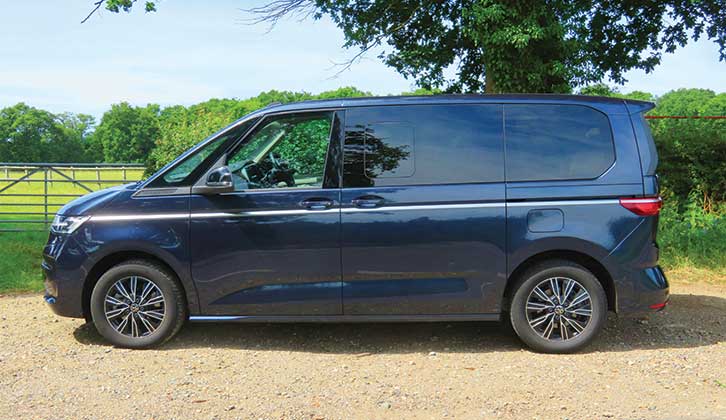
From the first few miles, the Multivan feels right at home towing. Stability is very good indeed. We tested the VW on a windy day but noticed only slight movements from the caravan.
Arrive at the campsite and the Multivan manoeuvres well, creeping smoothly at low speeds. All versions come with a rear-view camera, which makes it possible to hitch up alone without too much faffing about. The view over your shoulder is reasonably clear, too, thanks to the large windows, although the rear seats do get in the way a bit.
The towball drops down at the push of a button, and the electrics are on the side, well clear of the bumper. Hitching up the caravan is quick and easy.
As a tow car, the only significant criticism of the VW is poor traction. It’s possible to briefly spin the wheels when pulling away briskly from a junction. In fact, you’re likely to spin the wheels when making a hill start. Our testing was in the dry, so this could be more of a problem in wet weather. It’s just a shame that there’s no four-wheel-drive model available, which would boost the Multivan’s credibility as an SUV alternative, as well as an MPV.
Solo driving
For such a tall and heavy car, the VW Multivan drives well. Without the weight of a caravan to pull, the 2.0-litre engine has a healthy turn of speed. There’s plenty of punch for passing dawdling traffic.
Even when working hard, the engine is smooth and refined, and once cruising along, it stays in the background. Wind and road noise are kept to reasonable levels.
The DSG transmission makes the most of the car’s power, changing ratios promptly and smoothly. We rarely felt the need to take charge of gear selection ourselves.
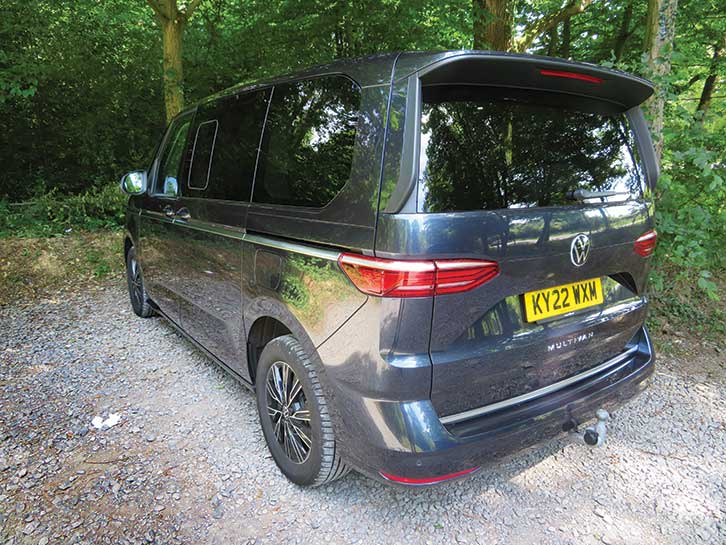
On country roads, you are conscious of the car’s size, but good visibility and accurate steering help the driver place the car precisely. It’s not a sporty drive, but that’s hardly surprising for a two-tonne MPV. It corners neatly, but there’s a bit of body roll if you get too enthusiastic.
Comfort is clearly a higher priority with a car like this, and the Multivan delivers a smooth and assured ride. You hear bumps more than you feel them, with a lot of thump from the suspension, but otherwise the Multivan is very pleasant to travel in.
Space and practicality
This is what the VW Multivan is all about. It just misses out on a five-star score here, because some of the VW’s rivals seat up to nine, whereas the Multivan has room for six or seven. But this is an exceptionally roomy and cleverly designed car.
Those in the front have lots of space, and the driver and front-seat passenger sit up high, even with the seats at their lowest setting. Headroom is plentiful, despite the panoramic sunroof fitted to our test car (a £1050 option).
There’s a configurable digital display instead of conventional dials in front of the driver, and the latest generation of 10-inch touchscreen infotainment. This looks good, but can be a little fiddly to use on the move. We’d also prefer proper buttons to the touch-sensitive pads used to control the air conditioning.
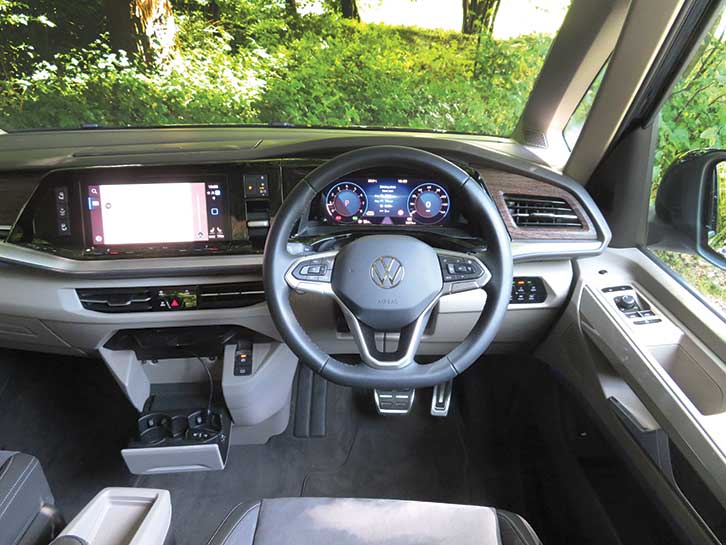
The cabin is finished to a good standard, although the plastics and wood trim don’t have the upmarket feel you’d get from an Audi or Mercedes of a similar price.
Passengers should be just as comfortable as the driver. Sliding side doors (powered on Style spec) give easy access to the back of the car.
Seven seats are standard, in a 2-2-3 formation. Having two individual chairs in the middle gives easy access to the back seats, with no need to slide the middle row out of the way.
Our test vehicle came with a six-seat layout, a no-cost option. This takes away the centre seat at the back, giving room for armchair-like seats for all passengers.
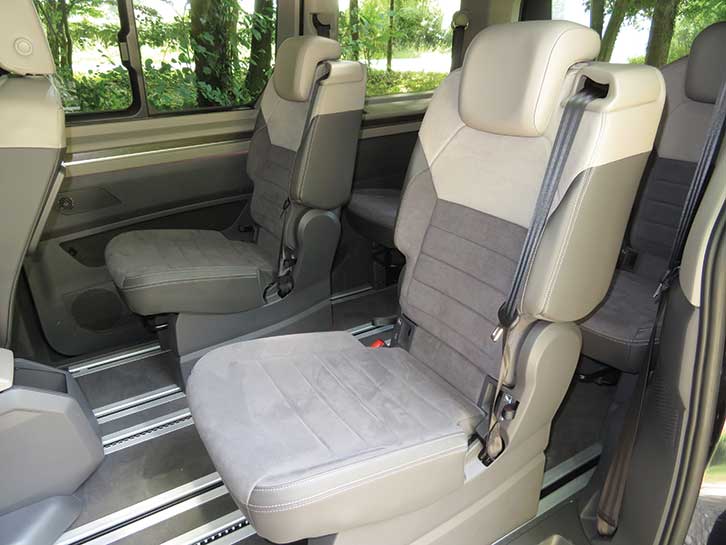
The centre and rear seats are on runners, so they move back and forth depending on who needs the most legroom and how much luggage is carried.
The seats in rows two and three can also be removed if you want your VW to live up to the ‘van’ part of its name.
One advantage of the six-seat arrangement is that the middle row of chairs can turn around to face the back – it’s a more sociable way to sit if you stop for a snack en route.
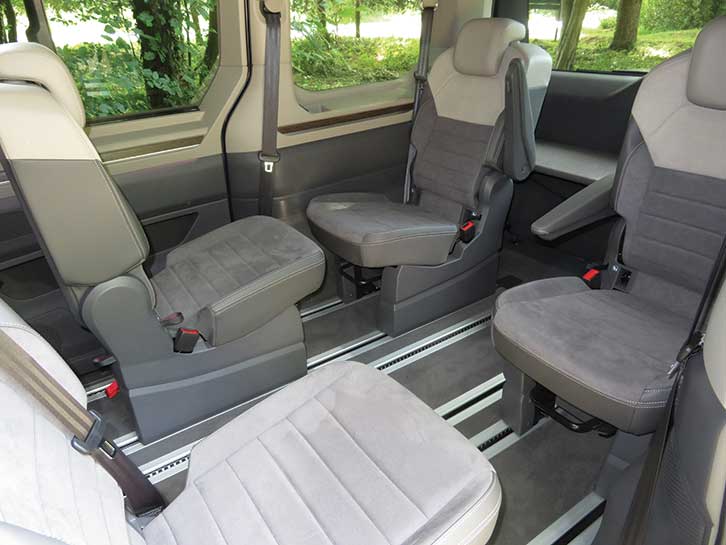
Another clever feature is the sliding centre console, which moves up and down the length of the cabin, rather like an airline service trolley.
You get good luggage space behind the rear seats, and there is a long-wheelbase version for those needing even more room.
Buying and owning
This is an expensive car, with a price tag of close to £60,000, and more if you go for a few of the optional extras.
Compare that with the £55,420 price of the most luxurious, long-wheelbase Toyota Proace Verso, and you can see there’s a premium to pay for the Volkswagen.
However, you do get lots of equipment as standard, including three-zone climate control, heated front seats, Apple CarPlay and Android Auto, keyless entry and start, and LED matrix headlights.
Running costs will be quite steep. The official combined figure is 31-31.4mpg, and we saw just 19.8mpg while towing.
Although the petrol model drives well, we’d be more inclined to choose the diesel or the plug-in hybrid for their lower fuel consumption.
Excellent resale values are predicted, which to some extent offsets the VW’s high price.
Verdict on the VW Multivan 2.0 TSI 204PS Style DSG
In many ways, the VW Multivan 2.0 TSI 204PS Style DSG is a brilliant car, as you may expect from a vehicle that was shortlisted for the best caravan tow car over 2000kg category at the Practical Caravan Awards 2023. It’s a very comfortable way to travel. The cabin finish might not quite live up to the near-£60,000 price tag, but every passenger has space to stretch out, especially if you pick the six-seat layout, rather than the default seven-seater.
Getting in and out is easy, thanks to the sliding rear doors. Moving to the back of the cabin is simple, too, owing to the space between the middle-row seats. We love the way the chairs move back and forth to better share the space between passengers, and the sliding centre console is a really clever feature.
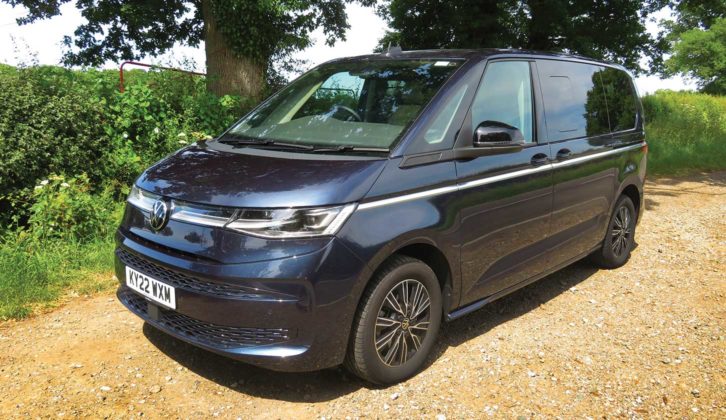
You choose a car like the Multivan for its practicality, but the driver doesn’t feel shortchanged. The ride is comfortable, and handling is composed. Go for the 2.0-litre petrol and there’s plenty of performance. By petrol standards, mid-range pulling power is strong, and the Multivan will quickly pull a sensibly matched caravan up to speed. The VW is stable as well as swift, with assured towing manners to put the driver at ease.
However, there’s no getting away from the petrol car’s thirst, in solo driving and while towing. If we covered a lot of miles, we’d go for the diesel, or for frequent short trips, the plug-in hybrid would have lower running costs.
It’s also a shame you can’t specifiy the Multivan with four-wheel drive. This would solve the traction problem we found when making hill starts and would make this large MPV a genuine alternative to big SUVs. Even with these reservations, we rate the Multivan very highly.
- Take a look at our caravan towing tips guide for our advice on how to stay safe and comfortable on the road.
Or you could try…
Ford Tourneo Custom Titanium
- Price: From £49,284
Enormously roomy and very stable, but not as quick as the VW Multivan.
Toyota Proace Verso
- Price: From £41,945
Up to nine people can travel comfortably in the brilliantly practical Proace Verso.
Citroën Spacetourer 1.6 BlueHDi
- 18-plate, 14,000 miles
- Price: £22,000
The roomy Spacetourer is a keen used buy and promises good fuel economy.
SsangYong Turismo 2.2D
- 17-plate, 65,000 miles
- Price: £13,290
The Turismo isn’t the most sophisticated drive, but it’s a lot of car for the money.
In detail
- Price: £58,253
- What Car? Target Price: £58,253
- Retained value after three years: 65%
- Kerbweight: 2123kg
- 85% of kerbweight: 1805kg
- Gross vehicle weight: 2850kg
- Max towing limit: 2000kg
- Gross train weight: 4850kg
- Towball limit: 100kg
- Price of towball and electrics: £900
- Boot size min/max: 469/1844 litres
- Payload: 727kg
- Test conditions: Dry
- Engine size: 1984cc
- Official combined economy: 31-31.4mpg
- Towing economy: 19.8mpg
- Power (hp)/rpm: 204/5000-6500
- Torque (lb ft)/rpm: 236/1600-4300
- CO2 emissions: 204-208g/km
- First year car tax: £1420
- Second year car tax: £520
- Insurance group: 33E
If you’ve enjoyed reading this article, why not get the latest news, reviews and features delivered direct to your door or inbox every month. Take advantage of our brilliant Practical Caravan magazine SUBSCRIBERS’ OFFER and SIGN UP TO OUR NEWSLETTER for regular weekly updates on all things caravan related.
Technical Specifications
| Engine Size | 1984 cc |
| Kerbweight | 2123 kg |
| 85% KW | 1805 kg |
| Towball Limit | 100 kg |
| Maximum Towing Limit | 2000 kg |
| Power | 204 bhp |
| Torque | 236 lb ft |
| Offical MPG | 31-31.4 mpg |
| Towing MPG | 19.8 mpg |
| CO₂ | 204-208 g/km |
